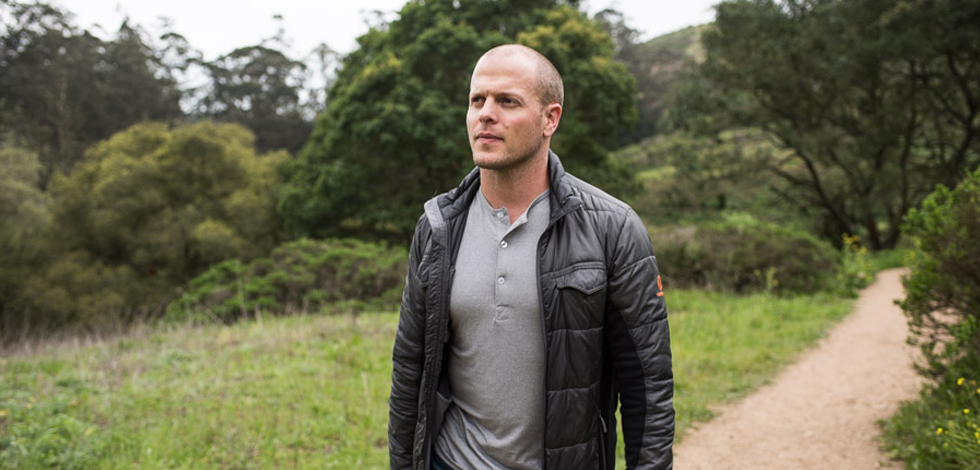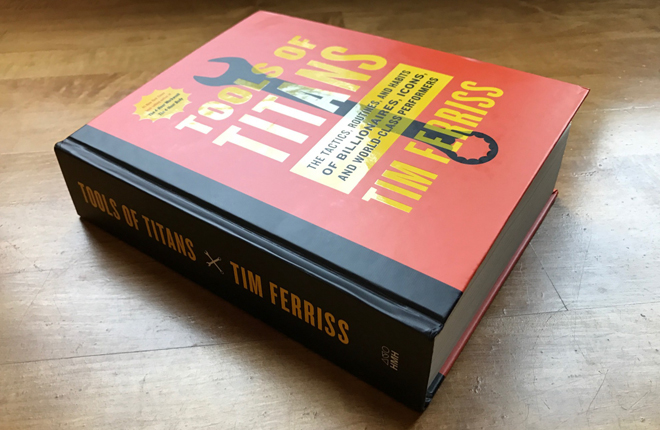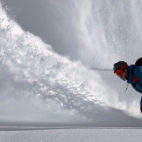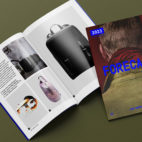Tools for Working from Anywhere with Tim Ferriss
At Carry HQ, Tim Ferriss is, without a doubt, a beacon. Be it in written word or podcast, we’ve gleaned countless insights from the man they call the ‘Indiana Jones of the digital age’. Lifehacking. One bag travel. Or tips to being an exemplary global citizen. He does it all. So when his new book Tools of Titans hit shelves, we jumped at the chance to interview the man who’s inspired us all, about what tactics, habits and routines pay off when you’re away from home and office…
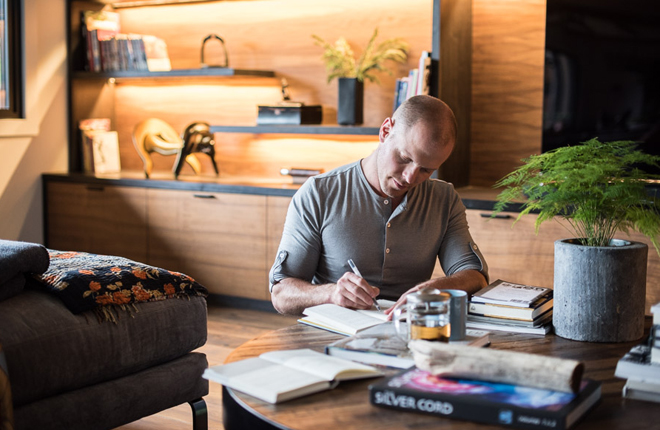
What’s your #1 piece of actionable advice for working remotely?
Embrace set routines.
As author Annie Dillard has said “A schedule defends from chaos and whim. It is a net for catching days.” This is particularly true when you work outside of an office environment. Offices offer reliable rhythms and schedules around which you can structure your time. Too much freedom can actually be paralyzing.
If you work remotely, you should — at the very least — have a “script” for the first and last 60 minutes of your day. This is the framework around which you can build the rest. Think of the first and last 60 minutes of your day as optimal boot-up and shut-down sequences, respectively. They should be close to auto-pilot and choice-minimal.
“If you work remotely, you should — at the very least — have a “script” for the first and last 60 minutes of your day.”
It’s been said that if you win the morning, you win the day. Even if my “morning” starts at 11am, which it sometimes does after a late night, below are five things that I attempt to do after waking. These will probably seem like small things, but just remember: The small things are the big things.
*The following list is adapted from Tools of Titans…
.
#1 — Make Your Bed (<3 minutes)
In 2011 in Toronto, I chanced upon a former monk named Dandapani (Dandapani.org) at an event called Mastermind Talks. I was going through a very scattered period in my life and felt like my energy was traveling a millimeter outward in a million directions. For grounding, he convinced me to start making my bed.
To quote Naval Admiral William McRaven, who has commanded at every level within the Special Operations community, including acting as head of Joint Special Operations Command (JSOC) during the Osama bin Laden raid:
“If you make your bed every morning, you will have accomplished the first task of the day. It will give you a small sense of pride, and it will encourage you to do another task and another and another. By the end of the day, that one task completed will have turned into many tasks completed. Making your bed will also reinforce the fact that little things in life matter.”
“If you make your bed every morning, you will have accomplished the first task of the day. It will give you a small sense of pride, and it will encourage you to do another task and another and another.”
#2 — Meditate (10 to 20 minutes)
At least 80% of all guests profiled in Tools of Titans have a daily mindfulness practice of some type. I often use Headspace or listen to Tara Brach’s “summer 2010 smile meditation,” which several interviewees recommended. Sometimes I will do “Happy Body” mobility exercises from Jerzy Gregorek in place of meditation.
When I’m done, I walk into the kitchen and flip a switch to near-boil water (about 85% of the full dial) using a cheap Adagio utiliTEA electric kettle. This is for tea (in step 4).
#3 — Do 5 to 10 Reps of Something (<1 minute)
I started doing this after numerous exchanges with former Navy SEAL Jocko Willink. He trains before most people wake, and I train when most people are getting ready for bed.
The 5 to 10 reps here are not a workout. They are intended to “state prime” and wake me up. Getting into my body, even for 30 seconds, has a dramatic effect on my mood and quiets mental chatter. My preferred exercise is push-ups with ring turn out (RTO), as it nicely lights up the nervous system. I’ll often take a 30- to 60-second pure cold shower after this, à la Tony Robbins. A short “bear crawl” or “quadrupedal warmup” from parkour, which is low-impact, can also do the trick.
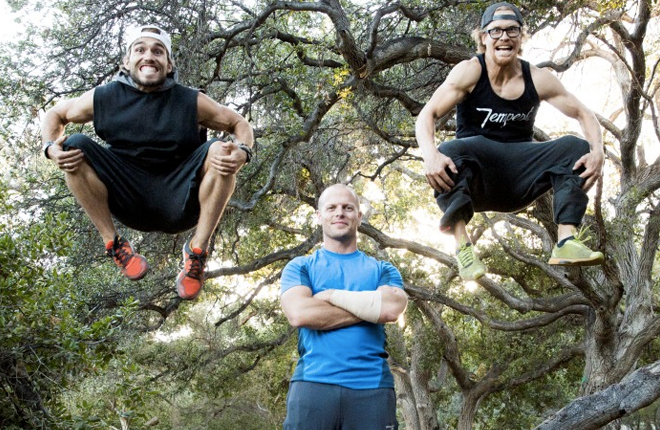
Parkour TFX
#4 — Prepare “Titanium Tea” (this name was a joke, but it stuck) (2 to 3 minutes)
I prepare loose-leaf tea in a Rishi glass teapot but you could use a French press. The below combo is excellent for cognition and fat loss, and I use about 1 flat teaspoon of each:
Pu-erh aged black tea
Dragon Well green tea (or other green tea)
Turmeric and ginger shavings (often also Rishi brand)
Add the hot water to your mixture and let it steep for 1 to 2 minutes.
Separately, add one of the following to your drinking mug: 1 to 2 tablespoons of coconut oil, which is about 60 to 70% MCTs (medium-chain triglycerides) by weight or 1 scoop of Quest MCT Oil Powder, which will give the tea a creamy consistency.
Pour your tea into your mug, stir to mix, and enjoy. In my case, I grab my tea, a glass of cold water, and then take a seat at my comfy acacia wood kitchen table for the next step.
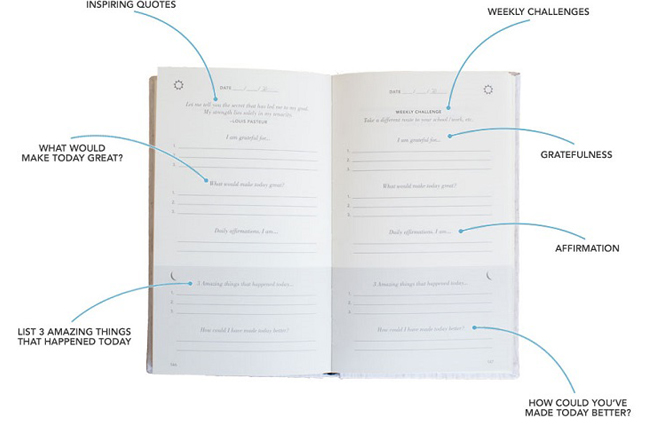
#5 — Morning Pages or 5-Minute Journal (5 to 10 minutes)
Next up is journaling, which is not a “Dear Diary” situation.
I use two types of journaling and alternate between them: Morning Pages and The 5-Minute Journal (5MJ). The former I use primarily for getting unstuck or problem solving (what should I do?); the latter I use for prioritizing and gratitude (how should I focus and execute?).
“I use two types of journaling and alternate between them: Morning Pages and The 5-Minute Journal (5MJ).”
The 5MJ is simplicity itself and hits a lot of birds with one stone: 5 minutes in the morning of answering a few prompts, and then 5 minutes in the evening doing the same. Each prompt has three lines for three answers.
To be answered in the morning:
I am grateful for . . . 1. __________ 2. __________ 3. __________
What would make today great? 1. __________ 2. __________ 3. __________
Daily affirmations. I am . . . 1. __________ 2. __________ 3. __________
To be filled in at night:
3 amazing things that happened today… 1. __________ 2. __________ 3. __________
How could I have made today better? 1. __________ 2. __________ 3. __________
Hope that helps get you started!
Which Titans seem most comfortable on the road? What common traits or approaches do you see in those most able to work from anywhere?
Two who come to mind are Matt Mullenweg, CEO of Automattic and founding lead developer of WordPress; and Derek Sivers, founder of CD Baby and one of the philosopher kings of programming. They have many things in common:
– They don’t travel with a lot of stuff.
– They look for opportunities to work in fun, novel environments.
– They are ruthlessly good at picking top priorities. I do this by looking at my to-do list and asking “Which one of these, if done, would make all the rest easier or unnecessary?”
– They routinely block out 2-5-hour periods of time for “deep work” on creative projects (writing, coding, etc.) without Internet or notification distractions. Single-tasking at its purest. Derek might go offline for weeks at a time.
– Otherwise, they splurge as needed for the fastest, most consistent wifi.
– Both have an incredible affinity for things they consider elegant or beautiful.
Can you show us what a typical workspace looks like when you’re away from home and office? What are the most important aspects of this setup?
The setup looks more or less the same regardless of where I am. Home, coffee shop, friend’s place, whatever, but here are a few basics:
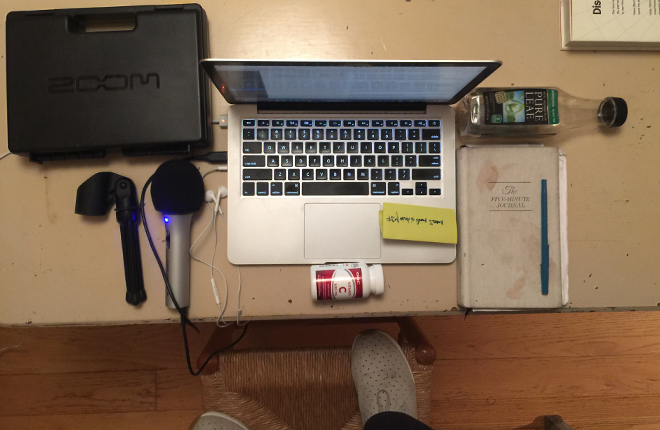
.
I’ll stand when I can, or use a treadmill desk at home, but this pic is from sitting at a friend’s living room table.
Elements:
– ZOOM recorder for in-person podcast interview (encased)
– ATR-2100 Audio-Technica USB mic for Skype interviews
– The 5-Minute Journal
– Unsweetened iced black tea
– Post-it note on my laptop with most important to-do (here folded over and, yes, super old school)
– Vitamin C — 500mg caps
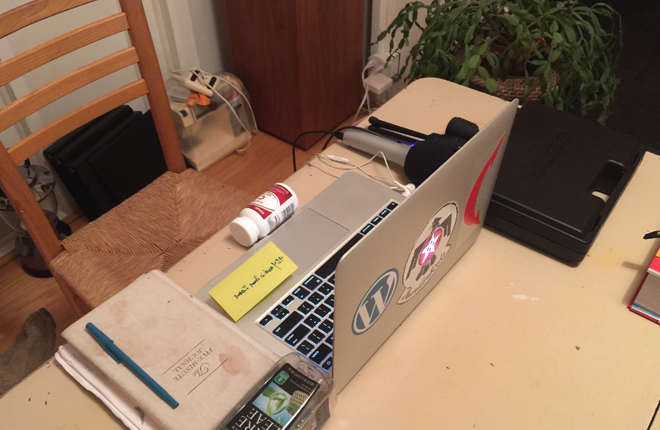
.
There’s loads of advice about staying healthy while traveling; what are the health hacks that make the biggest difference for you?
If I think my immune system will be compromised while on the road (e.g. meeting a lot of people, using public restrooms), or if I feel cold or flu symptoms coming on, my go-to stack is:
– 1g of vitamin C every hour
– Sprayable zinc 3-4x/day: upon waking and after meals, generally
– 1g of l-lysine 3-4x day, upon waking and after meals, generally
– Saline spray to keep sinal passages hydrated, as needed
Here are a few others:
The RumbleRoller — Think foam roller meets monster-truck tire. Foam rollers have historically done very little for me, but this torture device had an immediate positive impact on my recovery. It also helps you sleep if used before bed. I will use bungee cords to strap a small version to the outside of a carry-on backpack. Warning: Start slow. I tried to copy Amelia Boone (the world’s most decorated obstacle course racer) and did 20-plus minutes my first session. The next day, I felt like I’d been put in a sleeping bag and swung against a tree for a few hours.
The ChiliPad — Introduced to me by legendary music producer Rick Rubin. This has been life-changing for many people, who have eradicated insomnia and assorted sleep issues. Can, however, be tough to lug around. For something super low-cost and requiring less set-up, you could try a simple pre-bed cocktail: 2 tablespoons apple cider vinegar, plus 1 tablespoon raw honey, mixed in hot water.
Tera’s Goat Whey Protein — Introduced to me by famed strength coach Charles Poliquin. If you are lactose-sensitive, this can be a godsend. Even for those who tolerate dairy well, many (like me) find it easier to digest. I use a simple mason jar for mixing. If it’s too goaty for you — I find it very neutral — consider adding a tablespoon of beet root powder from BeetElite or another brand. Can be used both as a fast breakfast on the run, as well as an immune booster.
There are hundreds of options in Tools of Titans, but most people will get a lot out of at least one of the above.
What’s a non-obvious carry or travel tip that you think has oversized returns?
“Travel caching.” This can help you avoid checking any luggage whatsoever.
.
Let’s say that you’re flying to the same two cities 50-80% of the time, as I do, and staying in the same hotels. Why not keep a trunk in one or both cities with 7 days’ worth of clothing and other essentials inside? Here are some sample pics:
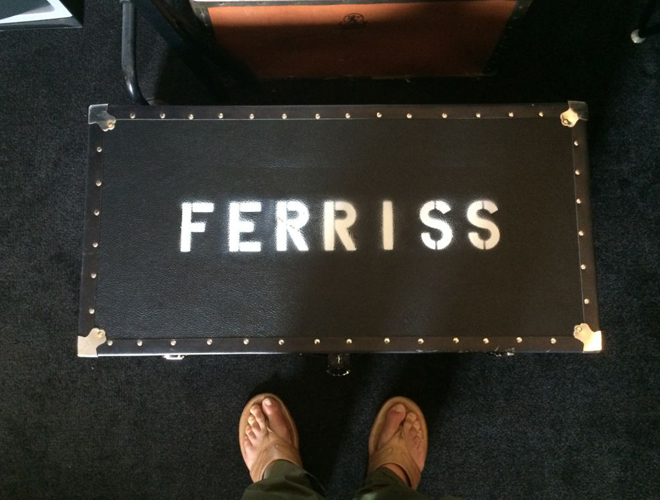
.
Believe it or not, the trunks have been provided and stenciled at no cost by the hotels! All I had to do was ask.
The best part: When I check out, I give a bag of dirty clothes to the front desk, they have it all cleaned and put back in my trunk, folded and pretty… ready for my next arrival! They charge it to the same credit card I have on file for rooms. Doubly cool: Since I stay there so often, they don’t charge me the in-house extortion prices. They take it down the street to an inexpensive clean-and-press laundry joint.
No packing, no checking, no unpacking, no cleaning. It’s magical.
““Travel caching.” This can help you avoid checking any luggage whatsoever.”
But, how can this possibly save you money and sanity? Easy:
1) To check an equivalent amount of stuff would usually cost $30+, so $60+ round-trip.
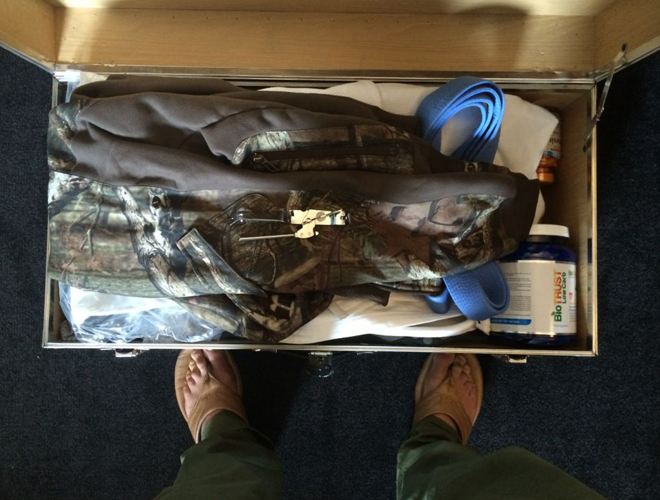
2) The clothing isn’t new clothing. Most of us have MUCH more clothing than we need. I simply leave one week’s worth of less-used stuff in NYC, for instance. No purchase necessary.
3) Two WEEKS’ worth of lentils, beans, and whey protein cost about the same as two DAYS of room service breakfasts. It’s also a ton faster. Waiting around makes me cray-cray.
4) If you stay in a hotel often enough, you can simply ask: “Do you have a trunk or something I could store a week’s worth of clothing in? That way, I wouldn’t have to pack so much when I come here.” The above trunk was given to me this way, but you can also buy one for $60 or so on Amazon, the equivalent of one trip’s baggage fees. Then ask the staff (who you should know by now) if you could store a week’s worth of clothing in the storage room, basement, or security office. This can also be arranged with many people on Airbnb.
And if your hotel or host won’t play ball, guess what? Startups can save you. Consider using MakeSpace or its close cousins, which one 4-Hour Workweek reader used to live like James Bond, all while vagabonding around the planet. Pretty cool, right?
Tools of Titans Giveaway!
If you haven’t laid eyes upon Tools of Titans yet, we can highly recommend it. It delves into the tactics, routines and habits of world ‘Titans’, individuals who’ve kicked serious butt in the game of life, and dishes up actionable insights on how we can do the same.
It’s the kind of book you carve out time to read and then have trouble putting down; you’ll feverishly scribble down notes, research products, have “ahhh” moments and epiphanies – in short, it’s epic!
If we had a Carryology book list (which would be awesome!) it would totally top the list.
And to celebrate its release, we’ve jammed with Tim and Huckberry on a prize pack that not only features a copy of his new book, but a swag of travel-ready carry and apparel recommended by the man himself.





 Carry Awards
Carry Awards Insights
Insights Liking
Liking Projects
Projects Interviews
Interviews
